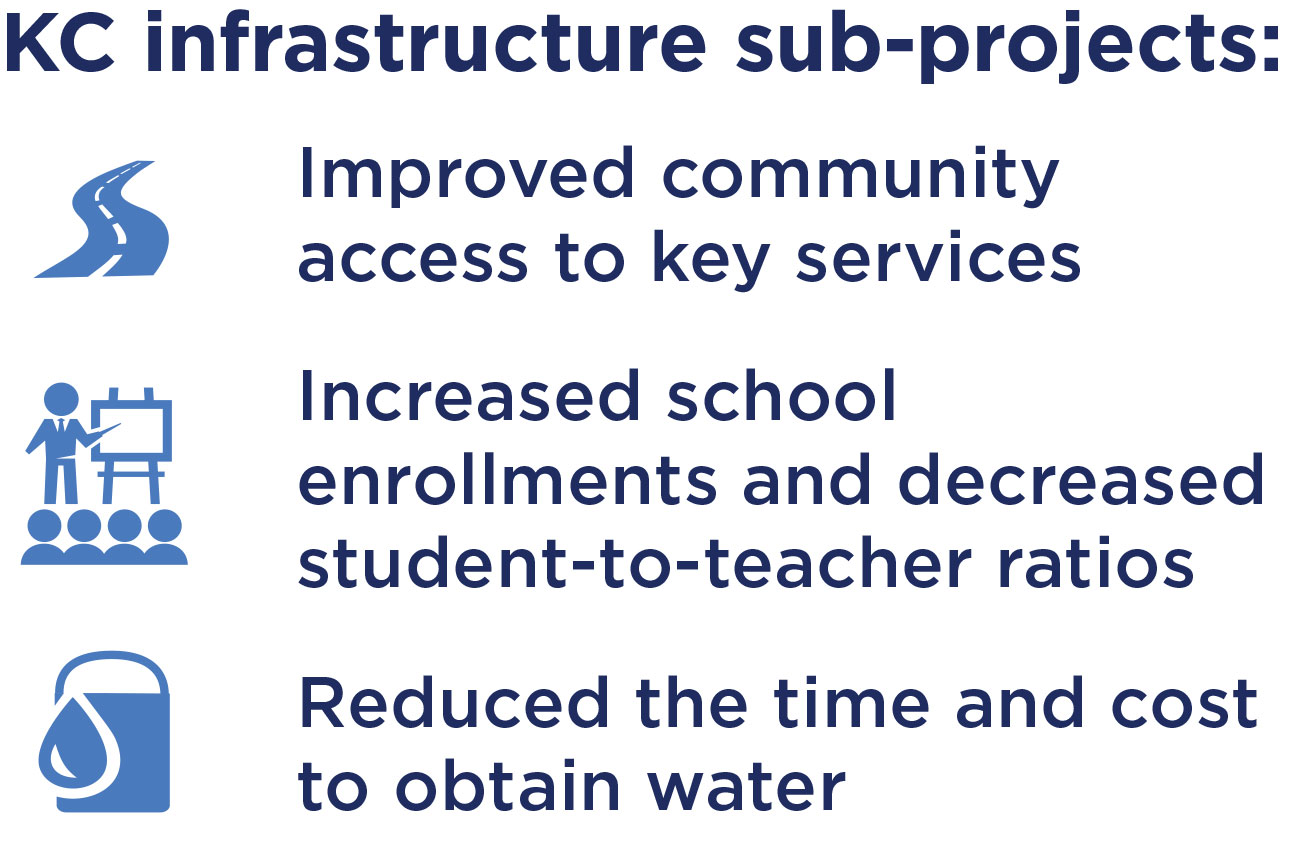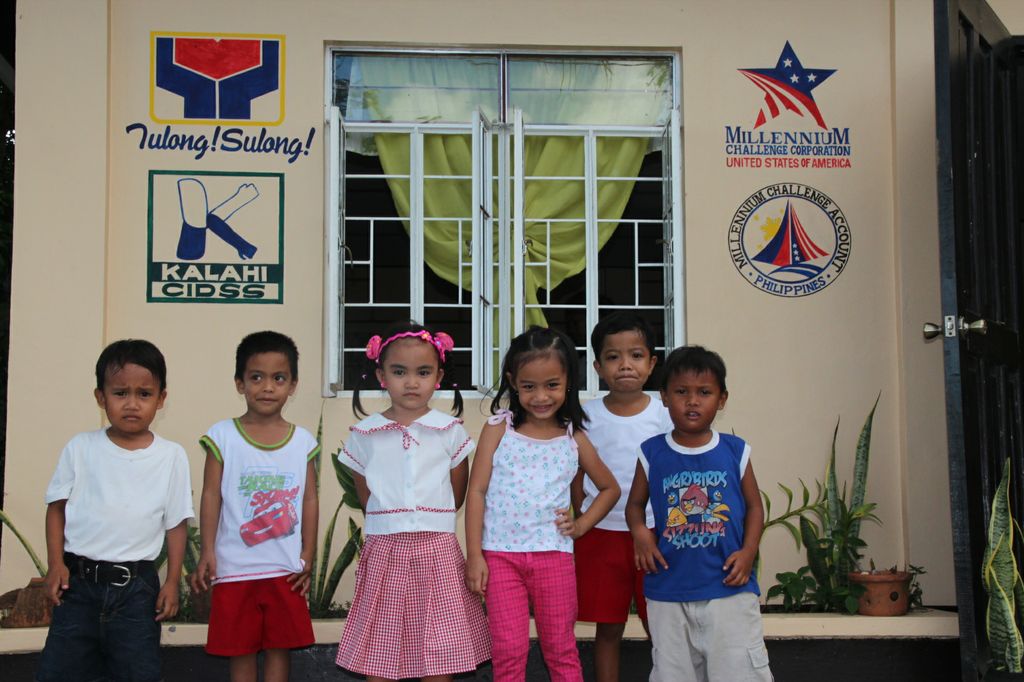Program Overview
MCC’s $434 million Philippines Compact (2011-2016) funded the $125 million Kalahi-CIDSS (KC) Community-Driven Development (CDD) Project, which aimed to reduce poverty, improve participatory local governance, and empower communities. The project trained community volunteers in more than 3,000 villages to address self-identified development needs, and financed more than 4,000 public infrastructure sub-projects (SPs). This evaluation focused on 160 MCC-funded villages and 38 World Bank-funded villages. The KC Project was based on the theory that CDD programs will empower communities and improve local governance, resulting in relevant, successful, and sustainable small infrastructure.Evaluator Description
MCC commissioned Innovations for Poverty Action (IPA) to conduct a final independent impact evaluation of the Kalahi-CIDSS Project. Full report results and learning: https://data.mcc.gov/evaluations/index.php/catalog/59.
Key Findings
Socioeconomic Welfare
- KC investments in water, transportation, and education infrastructure were effective in delivering benefits to residents via 4,000 citizen-prioritized sub-projects.
- Improved infrastructure decreased the time and cost spent to obtain water, expedited travel, and increased school enrollment. Yet, contrary to expectations, improved infrastructure reduced agricultural productivity.
Local Governance
- KC improved local government responsiveness to community needs and effectively delivered services that communities preferred, such as classrooms, health clinics, and farm-to-market roads.
- KC increased knowledge and awareness of local governance among residents of KC communities.
- Unexpectedly, residents in KC areas felt less able to make changes compared to non-KC communities.
Community Empowerment
- While KC encouraged communities to engage in development activities, it was less effective at generating broader social changes related to community empowerment after the project ended.
Differential Impact for Sub-groups
- Indigenous Persons (IPs) appear to benefit substantially more from improvements in access to education than non-IPs.
Evaluation Questions
IPA’s four-year mixed methods final impact evaluation was designed to measure the average treatment effects associated with a community’s participation in KC using a randomized control trial across three domains: socioeconomic, institutional, and community empowerment. Each domain included hypotheses, associated with a set of indicators that correlated with project outcomes. In addition, the evaluation analyzed whether impacts were different for identified sub-groups. This study addressed the following sub-set of questions:- 1 Socioeconomic: To what extent did SPs improve access to related key services; reduce time and costs spent transporting agriculture; improve agricultural productivity; reduce time and costs spent obtaining water; increase school enrollment and improve student/teacher ratios; and raise household consumption and income in KC villages?
- 2 Local Governance: To what extent did KC increase quantity and quality of participation in local governance around decision-making and implementation related to KC activities; increase knowledge and awareness of local governance; raise capacity and improve perceptions of barangay (“village”) government; and increase confidence and self-efficacy beyond KC?
- 3 Community Empowerment: To what extent did KC increase interactions among peers; increase participation in community organizations; and improve how well communities deal with natural disasters and other hardships?
- 4 Differential Impact: Were KC Project impacts different for the most vulnerable sub-groups—IPs, women, and poor households?
Detailed Findings

Socioeconomic Welfare
The KC Infrastructure SPs were effective at improving community access to key services, while showing no evidence that overall poverty status was affected. The construction of new classrooms through Education SPs had significant effects on educational outcomes, with increased school enrollments and decreased student-to-teacher ratios in KC areas compared to control areas (0.42 standard deviations). Water SPs substantially reduced the time and cost to obtain water.In general, households in villages with Funded Road SPs had improved access to key services, such as schools, health clinics, and markets. However, Road SPs had no effect on fishery, livestock, or poultry productivity, and unexpectedly reduced agricultural productivity. This is likely due to that fact that smallholder farmers shifted out of rice cultivation in villages where roads improved, though this evaluation was not designed to determine why farmers made this shift out of rice production. Since these smallholders typically have higher yields per hectare than larger holders, the average yield per hectare among remaining rice farmers declined.

Local Governance
KC participatory processes were more effective than the status quo at delivering services that communities preferred, such as classrooms, health clinics, and farm-to-market roads. Consistent with this finding, 94 percent of the control group identified the project as helpful, and 93 percent of respondents felt that the KC Project addressed the most important SPs. Residents in KC communities were also more familiar with local officials and governing bodies, and it was expected that they would use those skills outside of KC. At the same time, this knowledge was accompanied by a worsening perception of confidence and feeling less empowered to make change. Additionally, KC had no effect on participation in and knowledge of formal structures beyond KC.Community Empowerment
Exposure to KC activities led residents to contribute to other civic activities at greater levels. On the interim survey, the intensity and frequency of interaction with neighbors about problems in the village were rated as significant and positive, but by the third survey, these peer interactions were no longer rated as significant. By the third round, however, there was no evidence that KC communities were dealing any better with hardships or natural disasters. However, in 2015, before the third round of data collection, control groups began to implement the successor project to KC, the KC-National CDD Project (KC-NCDDP), funded by the Philippines government and World Bank, wherein the control group was exposed to socialization treatments. This may have diminished the measured impact of the project.Differential Impact for Sub-groups
Results were analyzed for different sub-groups (women vs. men, IPs vs. Non-IPs, and poor vs. non-poor). For most cases, there were no observable differential effects in the sub-groups. The only cases in which KC affected people differently were for IPs; IPs appeared to benefit substantially more from improvements in access to education than non-IPs.Economic Rate of Return
- 12.6% MCC Original Estimate
- 3% Evaluation-Based Estimate
MCC Learning
- The participatory KC process is better than the status quo at identifying residents’ small infrastructure preferences. Incorporating CDD-like processes into future projects should allow for selection, design, and/or siting of small community infrastructure that better matches community preferences.
- KC does not appear to have changed citizen participation in local governance beyond the project. If this is to remain a key aspect of the CDD theory of change, consider targeting local political leaders for capacity-building or other project interventions.
- The quality and sustainability of community infrastructure should be prioritized over cost and implementation time. In order to determine the appropriate design, consider both local design guidelines as well as international standards.
- It may be worth further research to test which implementation modality results in superior infrastructure quality. One can envision that a non-CDD implementation model with heavy citizen engagement and input at the outset could still generate projects that meet community needs.
Evaluation Methods
Randomized Control Trial
The impact evaluation findings are based on a randomized control trial in which a sample of 198 municipalities across the Philippines’ three main island groupings were randomly assigned to participate in KC or to remain part of a control group for three years. Baseline data collection took place April-June 2012, interim data collection February-June 2014, and third round data collection July-October 2015. Between baseline and interim survey, the exposure period was 1.5 years (or 1.5 cycles of KC) for the treatment group and nothing for the control group. Between baseline and endline, the majority of the treatment group got three years of exposure to the project and 75 percent of the treatment group got at least one small-infrastructure project while the majority of the control group was exposed to the social preparation phase of the project and only seven percent got a small-infrastructure project.Household and Barangay Surveys
To identify which barangay to survey in each municipality, the evaluators randomly selected one barangay, with a weighted probability favoring barangays with the highest poverty rates. Household surveys focused on questions related to: socioeconomic status; service access and travel times; household participation in government and non-government groups; impressions of government quality, inclusion, and responsiveness; feelings of confidence and self-efficacy; priorities for local programs; peer interactions; and responses to natural disaster and hardship. Barangay surveys asked government officials about their attitudes and experiences regarding socioeconomic conditions, government, empowerment, and community participation and the barangay’s budget and development programs.For the baseline, interim, and third round surveys, within each barangay, one barangay survey and 30 household surveys were administered. For the baseline and third round surveys, the sample size was 198 barangay surveys and 5,940 household surveys. The interim survey was administered to a sub-set of the barangays and households (40 treatment and 40 control barangays, and 30 households per barangay or 2,400 households).
Structured Community Activities and Barangay Assembly Observations

Focus Groups and Key Informant Interviews
At baseline (2012), focus groups and key informant interviews were conducted to better understand how community members understood their situations as they related to the study’s main outcomes of interest. Research teams conducted 72 focus groups across a sub-sample of barangays in 24 municipalities (12 municipality treatment and control pairs) from the study’s 198 municipalities. At the same time, 188 key informant interviews were conducted to get a sense of the perspectives of existing officials on issues within the communities.2019-002-2225


